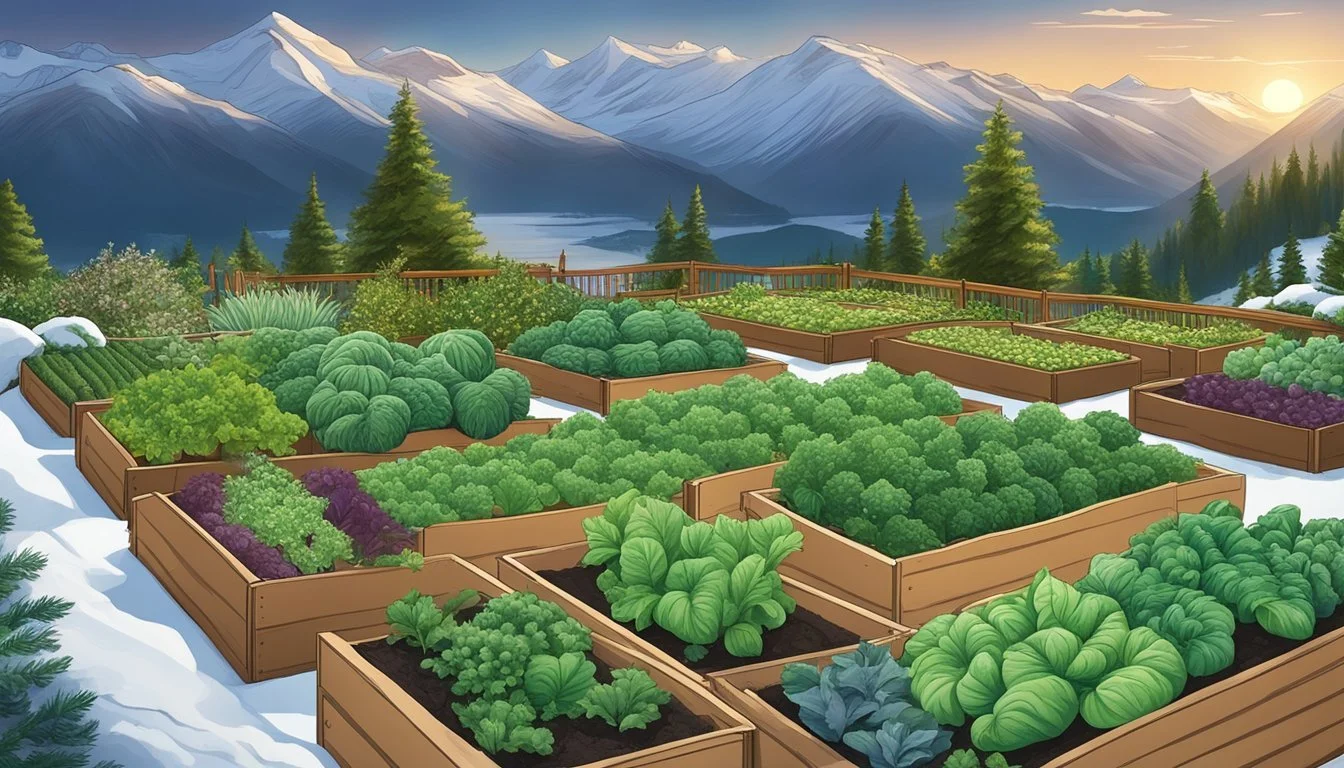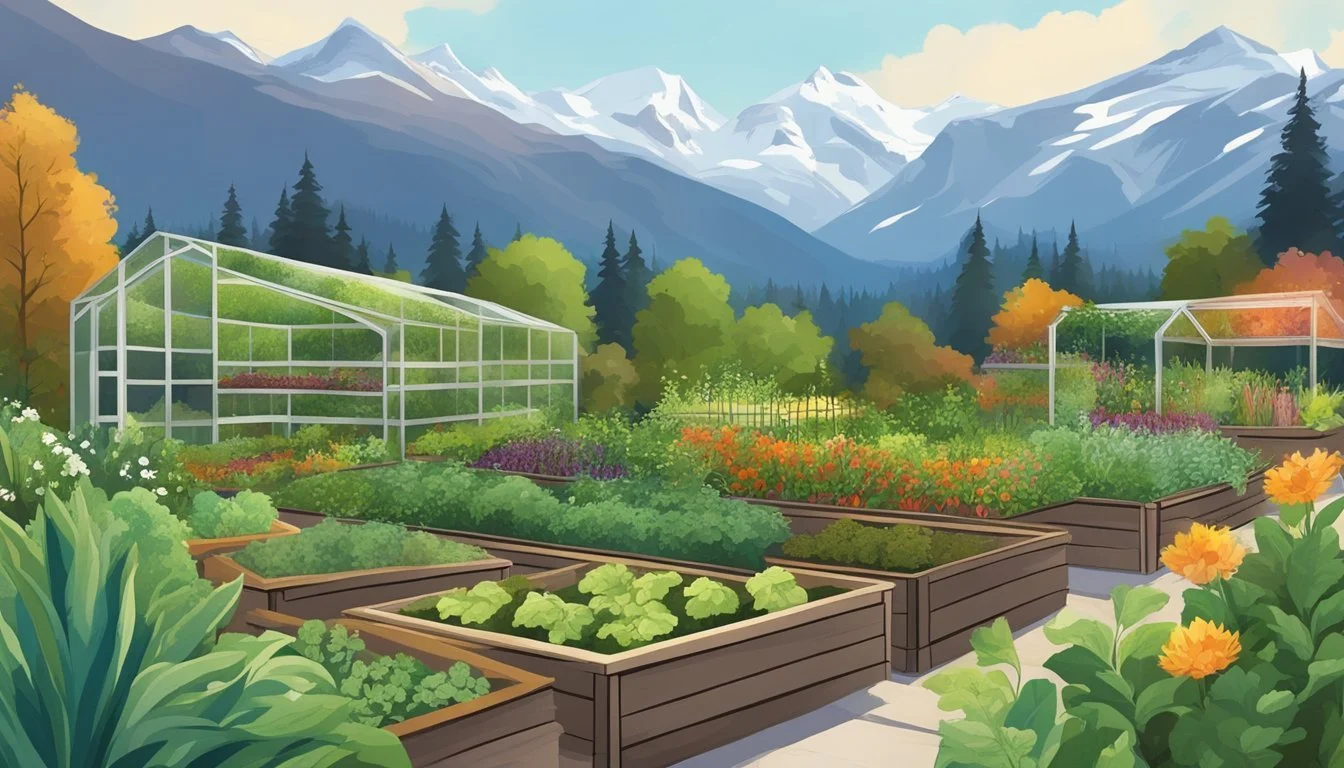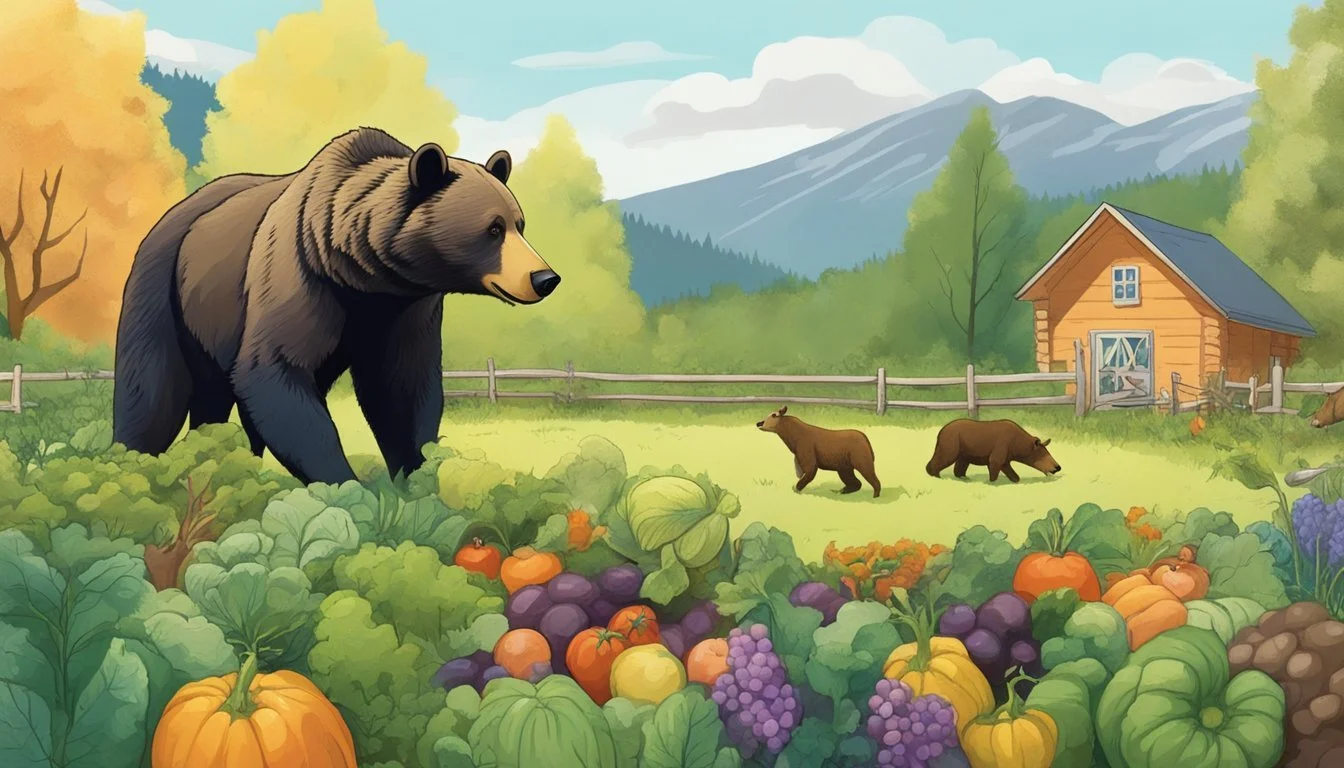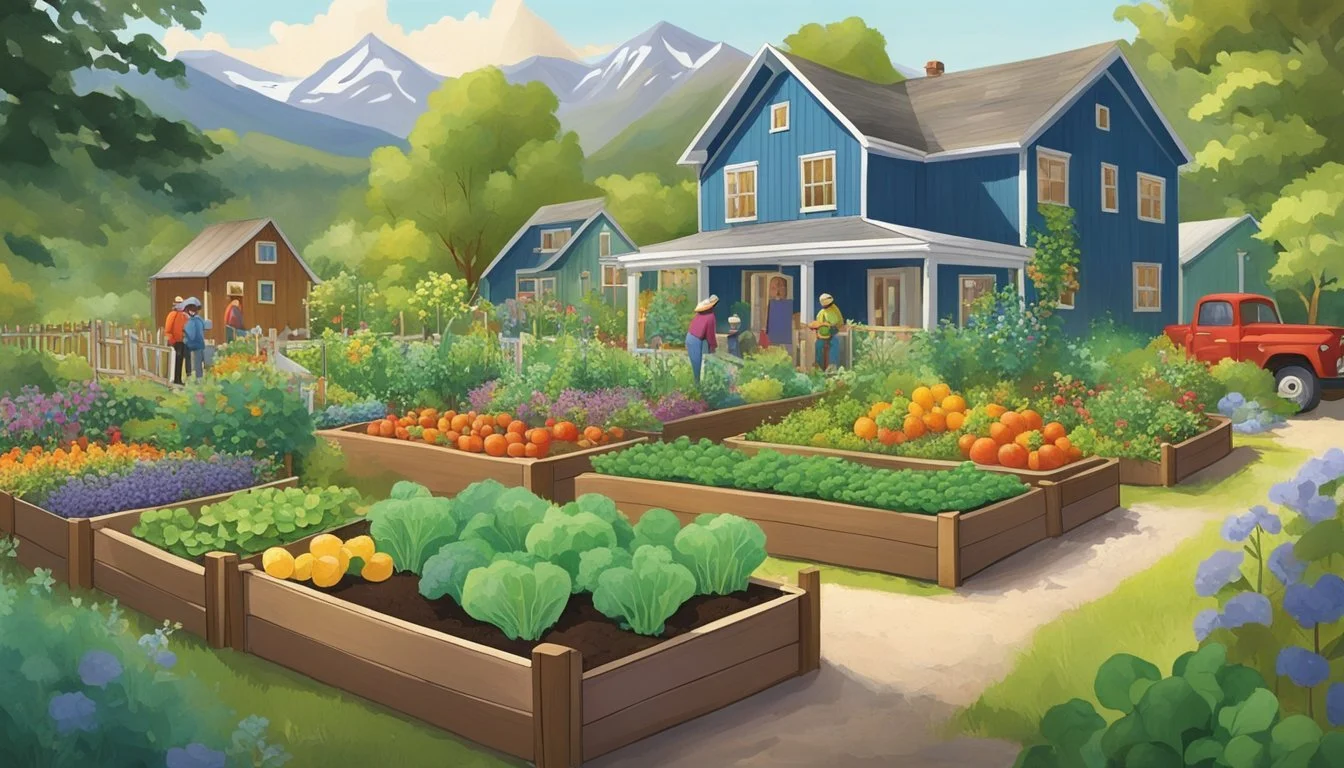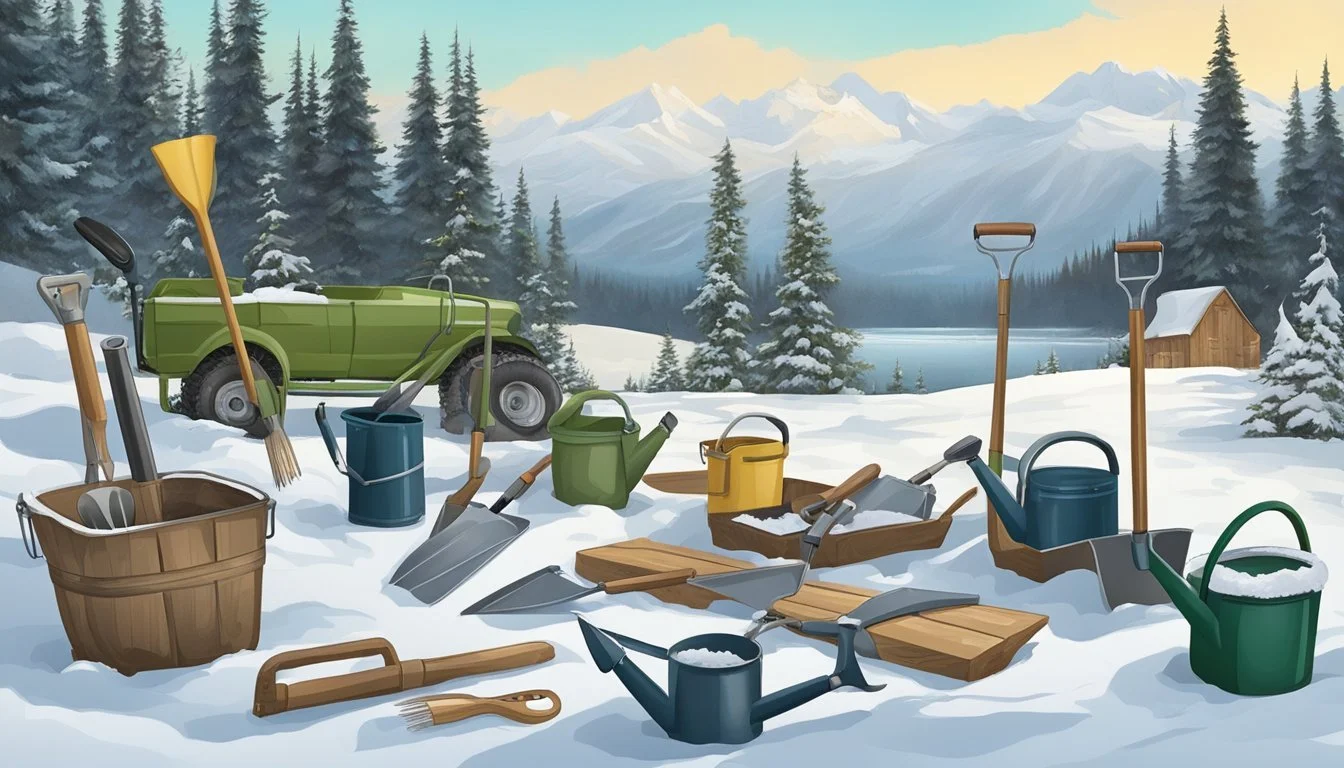Vegetable Gardening in Alaska
Mastering the Challenges of a Cold Climate
This Article is Part of Our Guide on Vegetable Gardening by State
Vegetable gardening in Alaska presents a unique set of challenges compared to other regions, stemming mainly from the state's colder climate and shorter growing season. However, despite these limitations, Alaskans have developed methods to cultivate a variety of vegetables successfully. The key to a flourishing vegetable garden in this northern landscape lies in selecting cold-hardy plants and employing season-extending techniques.
The foundation for growing vegetables in Alaska includes choosing the right varieties that can tolerate the cold and still thrive. Vegetables such as lettuce, cabbage, and root crops like radishes and turnips are well-suited to the Alaskan climate. These plants can withstand frost and some can even grow with snow on the ground, making them ideal candidates for the Alaskan garden. Gardeners in Alaska must also pay special attention to their garden's location, looking for spots that receive ample sunlight, have well-draining soil, and are protected from the local wildlife.
Careful planning and maintenance are critical for vegetable gardening in this region. Alaskans must take advantage of the long daylight hours in the summer to maximize plant growth. Additionally, simple structures like cold frames and greenhouses can extend the growing season, allowing vegetables to flourish even outside the relatively short conventional growing period. With the right strategies, gardeners can overcome the challenges posed by the Alaskan environment and enjoy a bountiful harvest.
Understanding Alaska's Unique Climate
Alaska presents a distinct set of climatic challenges for gardeners, marked by a notably short growing season and considerable light and temperature variations throughout the year. The state encompasses a wide range of hardiness zones and microclimates, which directly influence gardening strategies.
Short Growing Season
Alaska's growing season is considerably shorter than that of the lower 48 states, with a frost-free period ranging from as little as 60 days to 120 days, depending on the location. Gardeners must often start seeds indoors or use greenhouses to extend the season. Emphasis is placed on cultivating cold-hardy crops that can withstand a light frost and thrive in the northern climate.
Light and Temperature Variations
During the summer months, the Alaskan climate experiences extended periods of daylight, which can extend up to 20 hours in some regions. This phenomenon encourages rapid plant growth. Conversely, the temperature can fluctuate significantly, sometimes leading to instances of extreme heat or unexpected cold snaps that gardeners must be prepared to manage to protect their crops.
Hardiness Zones and Microclimates
Alaska is home to diverse USDA Hardiness Zones, ranging from 1b to 7b. This reflects the variety of climates across the state, from the very cold areas of the Interior to more temperate coastal regions. Understanding local zones and microclimates is crucial for selecting the right plants.
Zone 1b - 3b: Suited for extremely cold-hardy vegetables.
Zone 4b - 5b: Some hardy root crops and leafy greens thrive.
Zone 6b - 7b: A broader variety of vegetables can grow, including some that require more warmth.
Gardeners must assess their specific local conditions, as microclimates can create significant variances even within the same hardiness zone.
Planning and Designing Your Alaskan Vegetable Garden
Planning your Alaskan vegetable garden requires careful consideration of location, plant selection, and the use of space to ensure a successful harvest. The brief growing season and unique climate conditions make these steps crucial to gardening in the region.
Selecting the Right Location
The success of vegetable gardening in Alaska heavily relies on choosing an ideal location. A spot with maximum sunlight exposure for at least eight hours a day is beneficial. Raised beds or greenhouse structures can provide control over soil conditions and temperature, extending the growing period. For those with limited space, containers and vertical gardening techniques are excellent alternatives to make the most out of a smaller area.
Choosing Vegetables Suitable for Alaska
When selecting vegetables for your Alaskan garden, focus on cold-hardy varieties that can withstand cooler temperatures. Popular choices include lettuce, kale, and radishes due to their short growing times and tolerance to cold. Root vegetables like beets and carrots thrive in Alaska's soil, making them a staple for local gardeners. Incorporating these well-adapted vegetables ensures a bountiful yield despite the climate challenges.
Maximizing Space and Efficiency
Efficiency is key in Alaskan vegetable gardens. Utilize raised beds to improve drainage and soil warmth. Containers allow for greater control over the soil quality and are ideal for deck or balcony gardens. Vertical gardening maximizes limited space while also contributing to the accessibility and aesthetics of your garden. Combining these methods can help achieve higher productivity within a shorter growing season.
Soil Preparation and Planting Techniques
In Alaska's unique climate, soil preparation and planting techniques are vital to establish a successful vegetable garden. A gardener needs to focus on amending the soil for optimal growth, understanding the nuances of seedlings and direct sowing, and applying strategies like companion planting and crop rotation.
Amending Soil for Optimal Growth
Alaska's soil often requires amendment to support vegetable gardening. Gardeners should add organic matter such as compost or well-rotted manure to enrich the soil. For areas with acidic soil, incorporating lime can adjust the pH level, making it more conducive for vegetables to absorb nutrients. A simple table can guide how much to add:
Soil Type Amendment Amount Heavy Clay Organic Matter 4 inches Sandy Compost 3 inches Acidic Lime According to pH test results
Seedlings and Direct Sowing
Starting seedlings indoors is a common practice in Alaska to extend the short growing season. Use seed trays with a quality potting mix and maintain consistent moisture and warmth. When it's time to transplant outdoors, hardening off the seedlings by gradually exposing them to outdoor conditions is essential. For direct sowing, which works well for cold-tolerant crops, ensure the soil has warmed sufficiently and is well-drained to prevent seed rot.
Companion Planting and Crop Rotation
Companion planting can benefit Alaskan gardens by maximizing space and deterring pests. For example, planting marigolds near vegetables can repel harmful insects, while growing herbs like basil (how long does basil last?) can enhance the flavor of tomatoes. Crop rotation is important to prevent soil depletion and reduce disease risk; rotating families of vegetables like leafy greens, root vegetables, and legumes is a good practice. Use the following list for companion planting benefits:
Marigolds: deter pests near sensitive vegetables.
Basil: when planted with tomatoes, can improve taste and growth.
Legumes: fix nitrogen in the soil, benefiting subsequent plantings.
By diligently preparing the soil and carefully planning plantings, Alaskan gardeners can create productive and sustainable vegetable gardens.
Garden Management and Maintenance
Effective garden management and maintenance in Alaska require adapting to the unique northern climate. Key strategies include proper watering techniques, pest and disease control, diligent weed management, and season-specific plant care.
Watering Strategies for Northern Climates
In Alaska's variable climate, watering needs careful consideration. Gardens should be watered deeply yet infrequently to encourage strong root growth. Use a drip irrigation system to reduce water waste and ensure a consistent moisture level, which is crucial to prevent bolting in cooler weather.
Water early in the day to minimize evaporation and fungal diseases.
Ensure even soil moisture to prevent root stress.
Controlling Pests and Diseases
Gardeners must be vigilant against common pests like aphids and slugs, as well as diseases that can threaten vegetable crops.
Employ natural predators, such as ladybugs, for aphids.
For root maggots, use floating row covers and practice crop rotation.
Regular inspection helps early detection, preventing spread of diseases.
Weed Control and Mulching
Weeds compete with vegetables for nutrients and moisture. Mulching not only suppresses weeds but also helps maintain soil moisture.
Apply a layer of organic mulch around plants.
Regular thinning of the garden reduces weed growth and improves air circulation.
Plant Care Through the Seasons
Seasonal changes in Alaska are significant and each plant has its own requirements through these shifts.
Start seeds indoors and transplant after the last frost.
Use cold frames to protect early spring or late fall crops.
Monitor plants for signs of stress or bolting as seasons change.
Managing a successful garden in Alaska is demanding but rewarding, and through careful planning and maintenance, gardeners can achieve a bountiful harvest.
Extending the Growing Season
To maximize the yield from their gardens, Alaskan gardeners employ strategies to overcome the short growing season. Specific structures like greenhouses and high tunnels, as well as row covers and cold frames, play essential roles in this effort.
Greenhouses and High Tunnels
Greenhouses provide an environment where heat and humidity are controlled, creating conditions favorable for plant growth beyond the natural season limitations. High tunnels, simpler and unheated versions of greenhouses, function by trapping solar heat to extend the planting window. These structures are critical in Alaska for several reasons:
They allow for an earlier start to the season by providing protection from frost.
Heat retention enables a greater variety of vegetables to mature.
Protection from elements such as wind and rain reduces crop damage.
A typical greenhouse setup might include:
Feature Description Glazing Material Durable polycarbonate or glass Ventilation Roof vents or motorized windows Heating Propane or electric heaters Shelving Arranged to maximize space usage
Using Row Covers and Cold Frames
Row covers and cold frames are cost-effective solutions that offer protection against the cold, thus extending the growing season.
Row covers, made from various materials like plastic or garden fabric, are laid directly over plants or supported by hoops. They serve as a barrier against frost, insects, and animals.
Cold frames, typically consisting of a transparent top and insulated sides, create microenvironments for plants. Here's why they're effective:
They accumulate solar heat during the day, keeping plants warm.
They can be ventilated on sunny days to prevent overheating.
By insulating the soil, cold frames reduce temperature fluctuation.
These techniques, when applied correctly, significantly lengthen Alaska's growing period. Gardeners choose crops compatible with these methods, ensuring a successful harvest well beyond the standard season.
Harvesting and Storing Vegetables
Successful vegetable gardening in Alaska culminates with a productive harvest and the effective preservation of your bounty. The key is to understand the optimal timing for harvesting and the best methods for storing different varieties to maintain freshness and nutritional value.
Timing Your Harvest
Lettuce and Spinach: They should be harvested periodically once mature to ensure a continuous supply. These leafy greens do not store well for long periods, so frequent harvesting is beneficial.
Root Vegetables: Such as carrots and beets need to be monitored closely as they reach maturity. It’s generally best to harvest root vegetables before the ground becomes too hard, usually before the first deep freeze.
Vegetable Harvest Sign Storage Tip Carrots Bright color, firm texture Store in a cool, dark place but not in plastic Turnips Firm, unblemished skin Leave in ground until needed if the soil doesn't freeze Potatoes Foliage dies back and tuber skins toughen Cure for 2 weeks in dry place, then store in darkness
Preservation Methods
Root Vegetables: Can be effectively stored for months when placed in layers of moist sand in a cool, dark, and well-ventilated space. One can also preserve these vegetables by roasting or making them into pickled preparations.
Leafy Greens: Don't store well for long periods in their fresh state, they can be blanched and frozen for later use.
Fermenting: Vegetables like cabbage are often preserved through fermentation, turning them into long-lasting products such as sauerkraut (how long does sauerkraut last?).
Pickling: Is not only for cucumbers; many vegetables can be pickled to extend their shelf life and add flavor.
Alaskans benefit from understanding these techniques due to the short growing season, and utilizing these methods ensures that the hard work put into their gardens provides a yield that lasts well into the less productive months.
Beyond Vegetables: Incorporating Other Plants
While vegetable gardening is a key focus for Alaskan growers, incorporating herbs, flowers, and fruits can enhance the aesthetic appeal and diversity of your garden.
Including A Backyard Herb Garden
Herbs thrive in Alaska's cool summers, and a backyard herb garden can provide fresh flavors within steps of the kitchen door. Essential herbs such as chives, dill (how long does dill last?), cilantro, basil, and parsley can be easily grown. For instance:
Chives and dill prefer the cooler start of the growing season.
Cilantro and basil are suitable for the warmer midsummer months.
Parsley, being robust, can grow well throughout the season.
Using raised beds or containers can assist in controlling soil conditions and facilitate better growth for these herbs.
Adding Ornamental and Edible Flowers
Flowers can be both ornamental and edible, adding vibrancy and diversity to Alaskan gardens.
Calendula is notable for its beautiful yellow and orange blooms which are also edible and can be used to add color to salads.
By incorporating flowers among vegetables, gardeners can enhance pollination and improve overall garden health.
Moreover, certain flowers can deter pests, making them both a protective and ornamental addition.
Fruit and Berry Selection for Alaska
Fruit trees like the hardy fig can be grown in Alaska with some care and proper selection, while certain berries excel in the climate.
Strawberries are an excellent choice for Alaskan gardens, ripening in early summer.
The selection of fruit and berries should take into account the variety's resistance to cold and adaptability to the short Alaskan growing season. Bush beans, although not a fruit, are another plant that grows well alongside fruiting bushes and can help in fixing nitrogen in the soil, benefiting neighboring plants.
Dealing With Wildlife and Domestic Animals
In the challenging environment of Alaska, a gardener must prioritize effective strategies to guard against wildlife and domestic animals that may threaten crops.
Fencing and Protection Strategies
Fencing serves as the first line of defense against various animals such as deer, rabbits, and squirrels that view gardens as a source of food. Tall fencing is necessary, as some wildlife, like deer, can easily leap over shorter barriers. Electric fencing can offer additional deterrence.
For large animals (e.g., deer):
Height: At least 8 feet
Type: Solid fences to block the view, or electric to provide deterrence
For small animals (e.g., rabbits, squirrels):
Mesh size: No larger than 1 inch
Below-ground: Extend 6-12 inches underground to prevent digging
Safe and Humane Deterrents
Beyond physical barriers, humane deterrents can prevent wildlife from entering garden areas.
Visual deterrents: Flashing lights, scarecrows, or reflective tapes can deter birds and small animals.
Auditory deterrents: Noise-making devices can startle and keep animals away.
Olfactory deterrents: Non-toxic repellents can make plants less appealing to pests without harming them.
Always ensure any deterrents used are humane and do not harm the animals or the environment.
Community and Education
In Alaska, the emphasis on community and education in the context of vegetable gardening is evident through various local initiatives that provide resources and organize events aimed at promoting and supporting gardening efforts.
Local Gardening Workshops and Events
Local gardening workshops present opportunities for individuals to learn about the unique aspects of gardening in Alaska. These workshops cover a range of topics, from starting seeds to managing greenhouses, and are tailored to the specific challenges presented by the Alaskan climate. Events such as the "Garden and Gather" initiative help to increase knowledge sharing and community engagement.
Notable Workshops:
Seed Starting: Participants learn how to successfully start seeds indoors to prepare for the short growing season.
Composting in Cold Climates: This workshop teaches composting methods suitable for Alaska's colder temperatures.
Resources and Support Networks
Alaskans benefit from a variety of resources and support networks aimed at assisting gardeners. The Alaska Botanical Garden offers programs like their "Guided Gardening: Community Supported Agriculture (CSA)" to provide not just produce, but also education to its members throughout the growing season.
Key Resources:
Educational Materials: Guides on selecting the right crops and managing soil health.
Online Platforms: Websites and social media groups where Alaskan gardeners can connect, exchange tips, and share success stories.
By leveraging these workshops and resources, residents can overcome the challenges of vegetable gardening in Alaska's unique environment and enjoy the rewards of their harvests.
Tools and Equipment
Successful vegetable gardening in Alaska requires a selection of basic tools and specialized gear to extend the growing season. These items are essential for overcoming climatic challenges and ensuring a productive garden.
Basic Tools for Vegetable Gardening
A gardener in Alaska will need a variety of basic tools to manage their vegetable garden effectively:
Spade and Shovel: For turning the soil and preparing garden beds.
Rake: Essential for smoothing out soil and cleaning up garden debris.
Hoe: Useful for weeding and shaping soil.
Hand Trowel: Ideal for transplanting vegetables.
Pruning Shears: Necessary for trimming and shaping plants.
Watering Can or Hose: To ensure plants receive adequate water.
These tools should be durable and appropriate for the Alaskan environment, where weather can be harsh.
Season-Extending Gear
Given the shorter growing seasons in Alaska, season-extending gear is highly beneficial:
Greenhouses: Structures that create and maintain a warm, controlled environment for vegetables, thereby extending the growing season.
Cold Frames: Smaller than greenhouses, these are ideal for hardening off seedlings or protecting plants during colder spells.
Garden Fabric: Offers protection for vegetables against frost and can help to warm the soil.
Plastic Mulch: Helps in soil warming and moisture retention, which is particularly important during the cooler months.
These tools and supplies are crucial for Alaskan gardeners aiming to achieve a longer and more fruitful gardening season.
Conclusion
Gardening in Alaska presents unique challenges due to its climate. However, with the appropriate techniques and dedication, it can be a rewarding endeavor. Gardeners should focus on soil preparation, selecting suitable vegetable varieties, and employing strategies to extend the short growing season.
Key resources for Alaskan gardeners include:
Start Seeds Indoors: This gives plants a head start against the short growing season.
Season Extenders: Tools such as cold frames and greenhouses can protect vegetables from frost.
Mulching: Essential for moisture retention and weed suppression.
Gardeners in Alaska must be vigilant in selecting the right vegetables that can thrive in the cooler climate. Root vegetables, leafy greens, and members of the cabbage family are traditionally successful.
An ideal Alaska garden spot would include:
Sunlight: At least eight hours of direct exposure.
Soil: Rich, loose, and slightly acidic (pH 6.0-6.5).
Location: Away from large trees and shrubs, close to a water source and protected from wildlife.
Residents must leverage local knowledge and resources to achieve a fruitful garden. The Alaskan environment, though challenging, can yield an abundance of fresh produce with the correct approaches and commitment.




